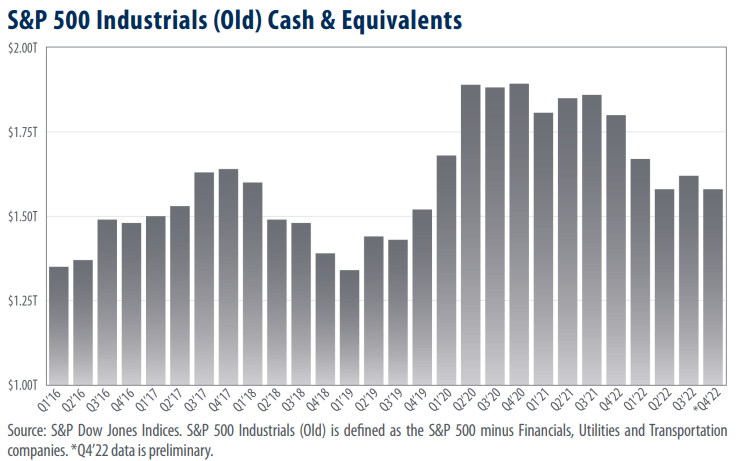
View from the Observation Deck
Today’s blog post provides a quarterly snapshot of the total cash and cash equivalent holdings of the companies that comprise the S&P 500 Industrials (Old) Index (“index”). Investors often use the level of cash held by companies, among other metrics, as a barometer of financial strength. Corporations, however, desire to earn a return on their capital, and holding cash well in excess of what is needed to fund short-term operations could prove to be detrimental to their ability to do so. The level of cash required for operations will vary from company to company, but a high-level view of the total cash holdings for companies in the index may offer unique insight into the overall business climate, in our opinion.
• After setting a record high of $1.89 trillion in Q4’20, arguably the height of the COVID-19 pandemic, the cash, and cash equivalents for the companies in the S&P 500 Industrials (Old) Index declined by approximately $310 billion to settle at $1.58 trillion as of Q4’22.
• From 3/09/09 (the low during the financial crisis) to 12/30/2022, the S&P 500 Index posted an average annualized total return of 15.65%, according to Bloomberg.
• What is interesting is that the companies that comprise the S&P 500 Index distributed $7.79 trillion in stock dividends and spent a staggering $11.61 trillion on stock buybacks over a similar period (3/31/09-12/30/22), according to S&P Dow Jones Indices.
Indicative of a massive divestment of cash, stock buybacks rose by 4.6% year-over-year from $881.7 billion in 2021, to a record $922.7 billion in 2022, according to S&P Dow Jones Indices. The pace does not appear to have slowed in the new year. In January, companies in the S&P 500 Index repurchased $132 billion of their stock, a record for the month. Likewise, dividend payments totaled a record $564.6 billion in 2022, an increase of 10.4% on an aggregate basis from 2021’s $511.2 billion. Bear in mind that S&P 500 companies also utilize cash for such things as mergers and acquisitions (M&A), investment in plants and factories, and to purchase software and equipment.
Takeaway
Broadly speaking, seeing S&P 500 Index cash holdings continue to rise over time suggests that America’s largest companies, overall, appear to be on solid footing, in our opinion. As indicated in today’s chart, total cash and cash equivalents fell from $1.89 trillion in Q4’20 to $1.58 trillion in Q4’22, but the decline may be related to share repurchases and dividend distributions, in our view. Stock buybacks and dividend distributions for companies in the S&P 500 Index each set record-highs in 2022, coming in at $922.7 billion and $564.6 billion, respectively. Furthermore, companies will often utilize cash as they engage in M&A and invest in property, plant, and equipment, among other capital expenditures. In our view, the record-setting pace of both stock buybacks and dividend payments could be viewed as a vote of confidence by corporations in their ability to weather current economic headwinds. Time will tell!



